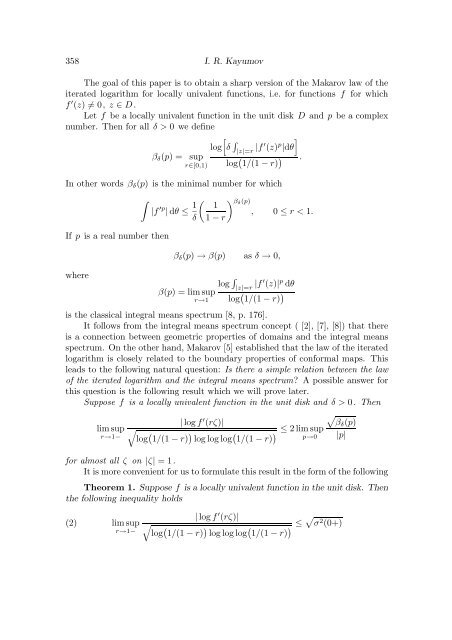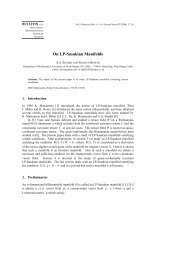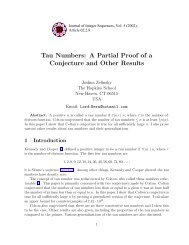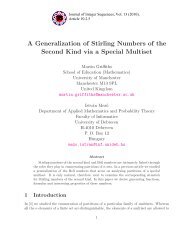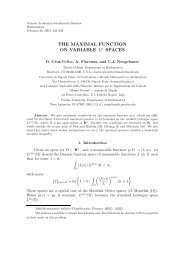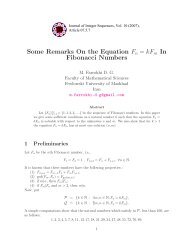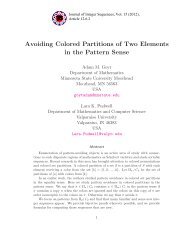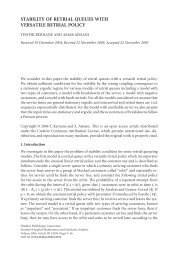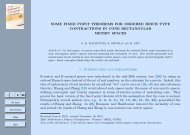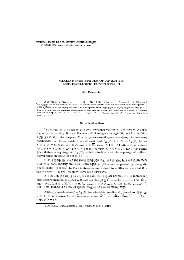the law of the iterated logarithm for locally univalent functions
the law of the iterated logarithm for locally univalent functions
the law of the iterated logarithm for locally univalent functions
You also want an ePaper? Increase the reach of your titles
YUMPU automatically turns print PDFs into web optimized ePapers that Google loves.
358 I. R. KayumovThe goal <strong>of</strong> this paper is to obtain a sharp version <strong>of</strong> <strong>the</strong> Makarov <strong>law</strong> <strong>of</strong> <strong>the</strong><strong>iterated</strong> <strong>logarithm</strong> <strong>for</strong> <strong>locally</strong> <strong>univalent</strong> <strong>functions</strong>, i.e. <strong>for</strong> <strong>functions</strong> f <strong>for</strong> whichf ′ (z) ≠ 0, z ∈ D .Let f be a <strong>locally</strong> <strong>univalent</strong> function in <strong>the</strong> unit disk D and p be a complexnumber. Then <strong>for</strong> all δ > 0 we defineβ δ (p) =logsupr∈[0,1)[δ ∫ ]|z|=r |f ′ (z) p |dθlog ( 1/(1 − r) ) .In o<strong>the</strong>r words β δ (p) is <strong>the</strong> minimal number <strong>for</strong> whichIf p is a real number <strong>the</strong>nwhere∫|f ′p | dθ ≤ 1 δ( ) βδ (p) 1, 0 ≤ r < 1.1 − rβ δ (p) → β(p) as δ → 0,β(p) = lim supr→1log ∫ |z|=r |f ′ (z)| p dθlog ( 1/(1 − r) )is <strong>the</strong> classical integral means spectrum [8, p. 176].It follows from <strong>the</strong> integral means spectrum concept ( [2], [7], [8]) that <strong>the</strong>reis a connection between geometric properties <strong>of</strong> domains and <strong>the</strong> integral meansspectrum. On <strong>the</strong> o<strong>the</strong>r hand, Makarov [5] established that <strong>the</strong> <strong>law</strong> <strong>of</strong> <strong>the</strong> <strong>iterated</strong><strong>logarithm</strong> is closely related to <strong>the</strong> boundary properties <strong>of</strong> con<strong>for</strong>mal maps. Thisleads to <strong>the</strong> following natural question: Is <strong>the</strong>re a simple relation between <strong>the</strong> <strong>law</strong><strong>of</strong> <strong>the</strong> <strong>iterated</strong> <strong>logarithm</strong> and <strong>the</strong> integral means spectrum? A possible answer <strong>for</strong>this question is <strong>the</strong> following result which we will prove later.Suppose f is a <strong>locally</strong> <strong>univalent</strong> function in <strong>the</strong> unit disk and δ > 0. Thenlim supr→1−| log f ′ (rζ)|√log ( 1/(1 − r) ) log log log ( ) ≤ 2 lim sup1/(1 − r)p→0√βδ (p)<strong>for</strong> almost all ζ on |ζ| = 1.It is more convenient <strong>for</strong> us to <strong>for</strong>mulate this result in <strong>the</strong> <strong>for</strong>m <strong>of</strong> <strong>the</strong> followingTheorem 1. Suppose f is a <strong>locally</strong> <strong>univalent</strong> function in <strong>the</strong> unit disk. Then<strong>the</strong> following inequality holds(2) lim supr→1−| log f ′ (rζ)|√log ( 1/(1 − r) ) log log log ( 1/(1 − r) ) ≤ √ σ 2 (0+)|p|


